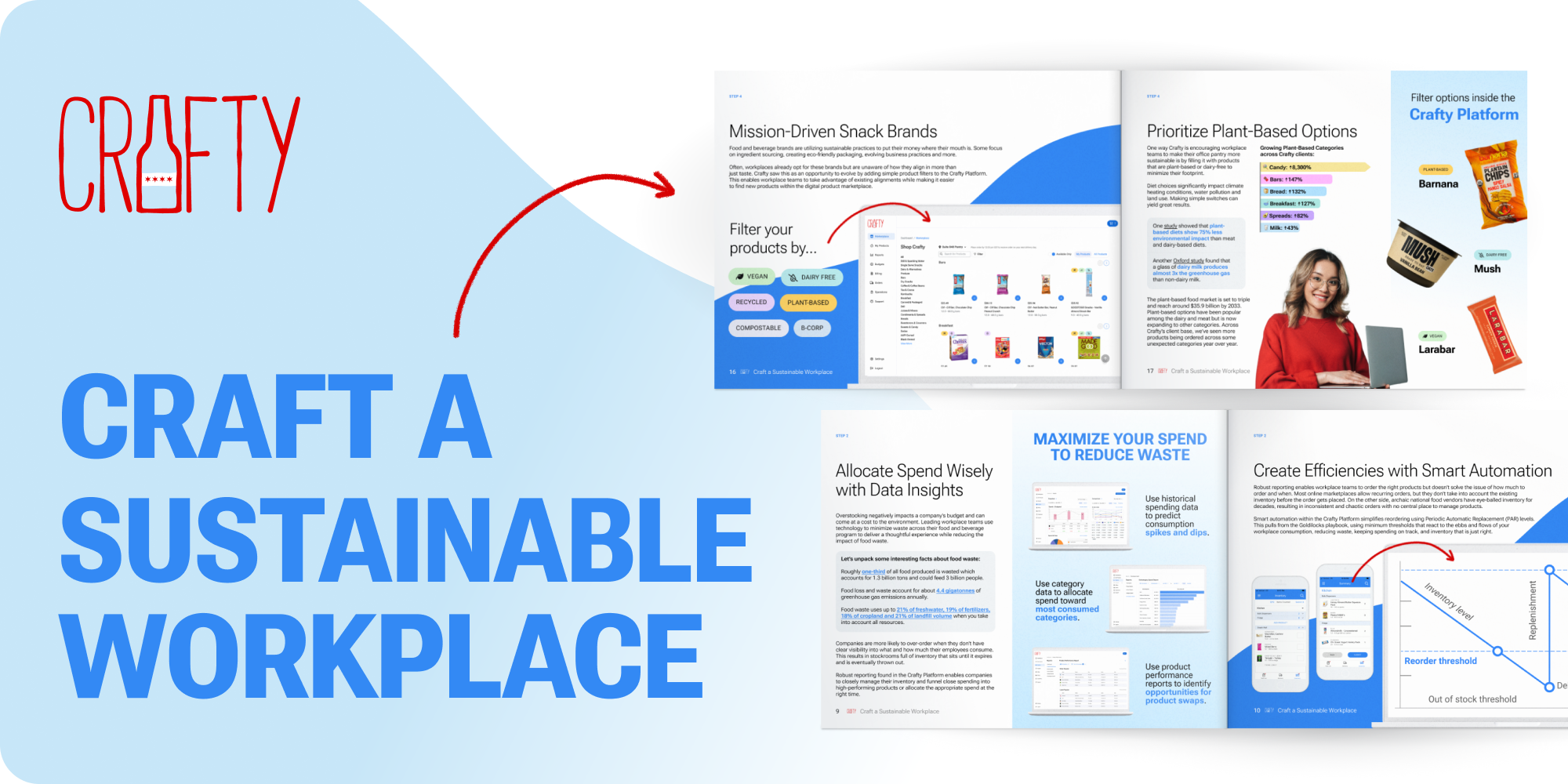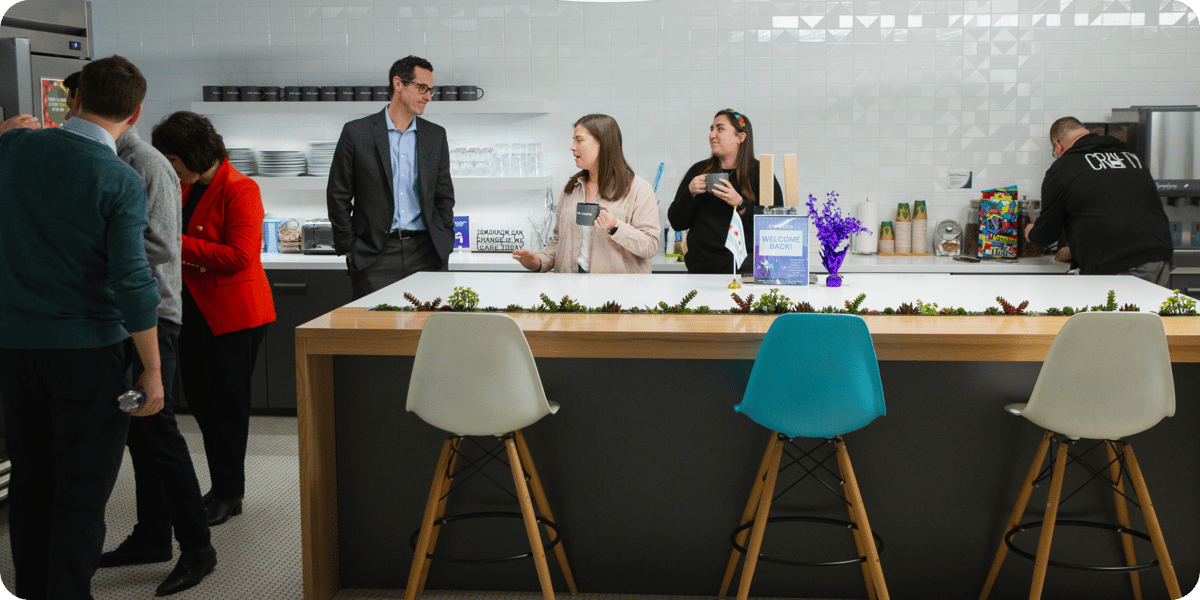From Farm to Office Pantry: How Crafty Gets Your Favorite Snacks To Your Desk
We take a peek behind the curtain to explore how Crafty sources, stores and supplies office snacks worldwide.
If you're one of the 90% of Americans who enjoy at least one snack each day, snacks probably cross your mind frequently—they offer us calories on the go, a midday treat to enjoy with coffee, or simply something to tide us over until dinner. If you peek behind the curtain—or in this case, wrapper—you'll see that our office snacks are the result of some highly technical processes that transform raw ingredients into packaged goodies you nosh on during long Zoom meetings or with colleagues during your lunch break. Let's take a look at the fascinating journey through the snack supply chain.
First, let's be clear about what we mean by the snack supply chain. We're referring to a complex web of people, processes, organizations, and activities that work together to produce, distribute, and deliver snacks to consumers like you. It includes everything from sourcing ingredients to those delightful snacks landing in the hands of eager consumers.
Now that we've clarified that, let's get into the details. Feel free to grab a snack, you're in for an adventure.
- How do food brands source raw materials?
- How are snacks processed and manufactured?
- How do food products get distributed?
- How do warehousing and storage impact snack delivery?
- Where do retailers fit into the snack supply chain?
- What are some common challenges in snack supply chain?
- What does the future of snacking hold?
If only there were a magic wand that turned plants in the ground and animals on farms into snacks instantly. Bad news: Jeff Bezos hasn't put one up on Prime yet. In the meantime, the first step in the snack supply chain is to source the raw materials. These can include ingredients like flour, sugar, corn, rice, vegetables, fruits, and dairy products. These raw materials are sourced from different parts of the world, like cinnamon from Indonesia or chocolate from Cote d'Ivoire, and depending on the type of snack being produced. Raw material sourcing is the foundation of the snack supply chain.
At Crafty, we don't cultivate raw materials—but we do make sure your snacks are up to snuff. We believe that responsible sourcing is not only the right thing to do, it is also good for our business and our customers. We employ a number of talented individuals who ensure that the ingredients that go into the products we supply meet the highest quality standards.
One of the challenges of raw material sourcing is ensuring a consistent supply of top-grade ingredients. Many factors can affect the availability and quality of raw materials, including weather, disease, and geopolitical issues. For example, according to the Harvard Business Review, the prolonged conflict in Ukraine and other international disagreements restricted the world supply chain in 2023.
According to Jeff Nash, our Senior Director of Merchandising, Crafty relies on its strong rapport with suppliers to navigate any hiccups in the supply chain." To mitigate the risks to our end consumers, our best plan of action is to strive to maintain close ties with our key vendors and distributors. We focus on providing clear and consistent information to be the best partners we can be, which sets our supply chain up for success."
Another important aspect of raw material sourcing is ensuring the safety of our ingredients. Nash explains, "The industry itself, through a series of regulations, ensures that risk to consumers is mitigated through strict safety standards. At Crafty, we work with the most reputable suppliers in the industry to ensure that packaged goods and raw ingredients are safe (and delicious) when they arrive at our clients' pantries." In other words, every Crafty snack is fully vetted—bite without hesitation.
How are snacks processed and manufactured? 🏭
Once the raw materials are sourced, they are processed and transformed into snack products through various manufacturing processes. This stage involves processes such as quality control, recipe formulation, and packaging. Some might say, "the fun stuff."
Manufacturing facilities are where the magic happens. The raw materials undergo a series of processing steps that vary depending on the type of snack product being made. These steps typically involve cleaning, sorting, and mixing the raw materials to create the perfect formula.
Once the raw materials have been processed and the recipe has been formulated, the next step is packaging. Packaging is critical, as it protects the product from external contaminants and ensures that it stays fresh and flavorful. Packaging can also significantly impact the consumer's perception of the product, as it is often the first thing they see when they pick up the snack off the shelf. Good packaging and even sizing can make a snack stand out and entice a consumer to try it. Perhaps you shouldn't let your mind judge a book by its cover, but your stomach will no doubt judge the snack by its packaging.
🚨 NEW REPORT
CRAFT A SUSTAINABLE WORKPLACE
Explore the five practices leading workplaces use to build sustainable office pantry programs.
If you’ve ever been on the highway early in the morning, you've probably witnessed what looks like a fleet of branded food trucks overtaking and then moving in various directions as they work to bring packaged goods to consumers across the country. This is the beauty of distribution at work!
Snacks can be found on store shelves and in vending machines nationwide, but they don’t appear by magic. The process of getting snacks from the manufacturer to the consumer involves an intricate journey through suppliers, wholesalers, and distributors, all working together to ensure that the right products are available in the right places at the right times.
But what happens after the products are received in the warehouse? This is where the real work of distribution begins. The distribution company must now coordinate the delivery of the products to their final destinations, whether that is a retail store, a vending machine, or your office kitchen.
Crafty wears many hats in this space. Not only do we act as a direct supplier in order to ensure nationwide coverage, but we also rely on the efficiencies of our vetted partner network to acquire the drinks, food, and beverages our employees crave. As a workplace food and beverage service, we manage the fulfillment of client orders.
"Manufacturers make all the products, then sell wholesale to suppliers in bulk,” says Nick Canada, Director, Partner Operations. "We purchase products directly from suppliers, or our partners do, and they are received in our warehouses. From there, the products are carefully investigated, inventoried, packed and then repackaged to ensure they make it to client sites on time and in the best conditions.”
At Crafty, this process involves careful planning and coordination, as well as the use of advanced warehouse management software to ensure that products are delivered when clients need them and in the right quantities. The distribution companies also work closely with us to ensure that the right products are available in the right quantities at all of our warehouses.
Trucks are the most common mode of transportation used in the snack supply chain. They are versatile and can carry large quantities of snacks over relatively short distances. Trucks can also navigate through narrow streets and deliver snacks directly to retailers, making them ideal for delivering to convenience stores and small supermarkets. Crafty owns specialized vehicles—such as trucks with refrigeration units—so products can be delivered at their peak freshness, whether it's a scorching hot summer day or a mid-winter freeze.
Despite the challenges, snack distribution is a vital part of the food industry and a point of pride for Crafty, ensuring that our clients have access to the products they want when they want it.
Warehouses are crucial for snack manufacturers who want to provide their customers with fresh, high-quality products. These facilities help manage inventory and ensure that products are available when needed. Let's explore how warehousing and storage play a vital role in the snacking industry.
One of the primary functions of a warehouse is to store products until they are ready to be shipped to retailers. Warehouses can store a wide range of goods, including snacks. They help manufacturers manage inventory and ensure that they can fulfill orders quickly and efficiently.
In the snacking industry, warehouses are particularly important because they help ensure that products are always within reach. Whether it's a bag of chips, a candy bar, or a package of cookies, customers expect to find their favorite snacks at their local grocery store or online marketplace. Warehouses make this possible by storing products in a central location and ensuring that they can be shipped quickly to retailers.
Another essential function of a warehouse is to ensure that products are stored properly. Snacks, like many other products, can be affected by temperature, humidity, and light. If snacks are not stored correctly, they can lose their flavor, texture, and overall quality. Warehouses play a crucial role in ensuring that snacks are stored in optimal conditions. They can control temperature, humidity, and light levels to ensure that products remain fresh and tasty. Every snack has its own unique specifications and challenges.
"Shelf-stable dry goods are typically just stored in their packaging on pallets and on racking in the warehouse. Perishables are stored in a conditioned environment, usually large walk-in refrigerators," says Canada. "Bananas have their own challenging environment they need to be stored in."
In addition to storing products, warehouses can also provide other services that help manufacturers manage their supply chain. For example, some warehouses offer pick-and-pack services, which involve selecting individual products from inventory and packing them into boxes for shipping. This service can be particularly useful for snack manufacturers who need to fulfill orders quickly or who want to customize their shipments based on customer preferences. Crafty in a Box is one such offering: it allows employers to send curated employee snack boxes to remote workers, or customize a snack box for smaller offices—whether you're a start-up of 10 or just want the perfect energizing mix for a day-long all-hands.
Finally, inventory tracking and management systems are used to monitor stock levels, forecast demand, and ensure that snacks are readily available to meet consumer needs.
When it comes to the world of food processing and manufacturing, inventory management is a crucial component of ensuring that snack products are readily available to meet consumer demand.
From the distribution centers, the snacks are sent to various retail outlets. These outlets include grocery stores, convenience stores, vending machines, and online retailers. Grocery stores are perhaps the most common place to find snacks, as they offer a wide variety of options and often have sales and promotions that make snacking even more affordable. Convenience stores are another popular option, as they are often open 24 hours and provide snacks for people on the go.
Vending machines are a convenient way to get snacks when you're out and about. These machines can be found in a variety of locations, from schools and office buildings to airports and train stations. They offer a quick and easy way to grab a snack when you're in a hurry, and many vending machines now offer healthier options like nuts and dried fruit.
Finally, online retailers are becoming an increasingly popular option for buying snacks. With the rise of e-commerce, it's now possible to order snacks directly from the manufacturer or from online retailers like Amazon. This is a great option for people who don't have access to physical retail outlets or prefer having snacks delivered right to their door. Crafty is a new kind of office snack delivery service, which stocks goods directly where the end consumer—that's you—is able to grab a snack whenever you need one at the office.
Of course, the process of getting snacks from the factory to your mouth isn't always smooth sailing. There are a number of challenges that can arise along the way, from supply chain disruptions to delivery delays. Manufacturers and retailers work hard to keep these disruptions to a minimum, but sometimes things happen that are out of their control.
On a macro level, natural disasters, such as flooding, earthquakes, wildfires, or high winds can damage production facilities, which can halt or shut-down manufacturing for an unknown period of time. When it comes to office snack delivery, issues like product recalls, labor shortages, changing consumer tastes, and material scarcity can make it harder for snack vendors to deliver your favorite snacks every time.
To mitigate these unforeseen issues, many companies choose to diversify their supplier base, create contingency plans for extreme situations, and establish strong relationships with suppliers to ensure smooth communication when something does go awry.
Snacking is sticking around. According to a Mordor Intelligence report, the snack food market is projected to increase from $256.26 billion in 2023 to $559.26 billion by 2028.
The snack industry is constantly evolving, and technology and innovation are driving this change. As consumers become more health-conscious, snack companies are exploring new ingredients and manufacturing techniques to create healthier snack options. For example, some snack companies are using air frying or vacuum frying to reduce the fat content of their products. Many consumers are now looking for snacks that do double-duty: ones that satiate hunger, but also offer an added benefit or function, such as probiotics for gut health or calming herbs for a sound night’s sleep.
In addition, snack companies are also exploring new flavors and textures to keep up with changing consumer preferences. The use of artificial intelligence and machine learning is helping snack companies to analyze consumer data and develop new flavor profiles that are tailored to individual preferences, as many snackers are seeking flavors that expand their horizons and taste buds, purchasing snacks with ingredients from other countries and cultures: gochujang-flavored chips, chili-spiced mango, or yuzu seltzer.
Lastly, there are many consumers who want to be assured that everything they consume is produced in a way that has a beneficial or neutral impact on the environment and people—according to Mondelēz International, approximately 63% of global consumers now seek snacks that reduce environmental impact. These snackers look for organic ingredients, recycled packaging, no animal testing, and fair labor practices in snack production. In other words, conscious consumption is hot.
FEATURED SPOTLIGHT:

"We continue with Crafty because of their ability to extend our bandwidth."
Conclusion 🏁
The snack supply chain is highly dynamic, with many stakeholders working together to ensure that consumers have access to a wide variety of snack products. It involves careful coordination, efficient logistics, and a focus on quality to deliver snacks to the market in a timely and safe manner.
The next time you reach for a bag of Barnana's banana bites or some C2O coconut water, remember all the work required to manufacture those treats and love your snacks for the long journey they took to arrive at your desk
Explore the Craftyverse
CRAFT
A BETTER
WORKPLACE?
Elevate your office food and beverage program with enhanced services managed in one innovative, centralized platform.














